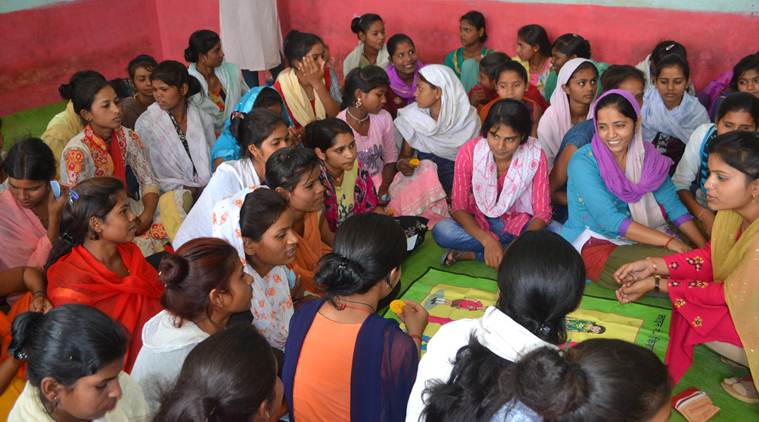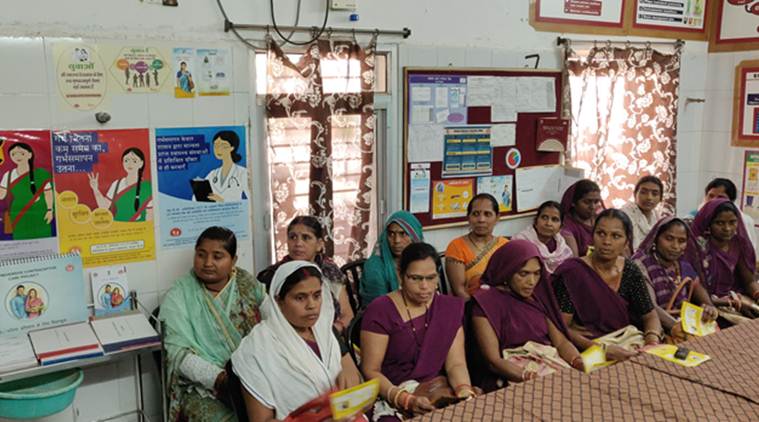- India
- International
In Madhya Pradesh, an innovative solution that shows the way to end unsafe abortions
Madhya Pradesh, according to a 2015 Guttmacher Institute report, is among six states where the maternal mortality rate is higher than that of India — 221 compared to 167 deaths per 100,000 live births.
 A youth-led intervention in Madhya Pradesh. Since early 2018, potential youth leaders in the villages are being trained to reach out to girls between 15-24 years of age, a group that is vulnerable to early marriage.
A youth-led intervention in Madhya Pradesh. Since early 2018, potential youth leaders in the villages are being trained to reach out to girls between 15-24 years of age, a group that is vulnerable to early marriage.
Clad in a hospital gown, Rukhsan Banu waits outside the MTP OT (Medical Termination of Pregnancy Operation Theatre) at the Elgin Rani Durgavati Hospital in Jabalpur. The 24-year-old, just over two months pregnant, does not want to keep the baby. “My husband and I have two children and we don’t want any more”.
Rukhsan and her sister-in-law travelled for over three hours from their home in Seoni village to come here for the procedure. The operation theatre, which opened in September 2017, is the first of its kind at a government hospital in India.
“Earlier, women coming here for abortions would have to wait hours, even the entire day, along with other patients,” says Dr Bhavna Mishra, a senior gynaecologist here. “Now, there is an operation theatre, RMO (Resident Medical Officer) and nurse dedicated for abortions. This is encouraging more women to come forward for the service.”
The response is encouraging given that unsafe abortion is the third leading cause of maternal mortality in India. Madhya Pradesh, according to a 2015 Guttmacher Institute report, is among six states where the maternal mortality rate is higher than that of India — 221 compared to 167 deaths per 100,000 live births.
The report says that 50 per cent of the pregnancies in 2015 in this state were unintended, with a majority (65 per cent) ending in an abortion. Since just 14 per cent of MP’s public health facilities can conduct abortions, 69 per cent of the abortions took place in non-facility settings using MMA (Medical Methods of Abortion, a non-invasive method using mifepristone and misoprostol). This left a substantial section of the population unserved, forcing many women to turn to quacks and other untrained people.

Rukhsan’s babies, for instance, were delivered at home by an untrained midwife because there was no government facility within reach. She found out about the MTP OT in Jabalpur when she accompanied a relative to this hospital last year. “It looked clean, quiet and organised, so I decided to come here for the abortion.” Rukhsan plans to get a tubectomy done as well to avoid getting pregnant in future.
 During a meet held by ASHA workers.
During a meet held by ASHA workers.
“We tell women who have two children to adopt a birth control method,” says Anita Salvi, the nurse in-charge, “and if they are open to the idea, counsel them on the options”.
On an average, 50 abortions are conducted at this hospital every month, with many women coming from distant villages.
The MTP OT is among the highlights of a sustained, multi-pronged intervention launched in 2006 in MP by the Ipas Development Foundation (IDF) as part of the Comprehensive Abortion Care (CAC) programme. The aim is to make abortion services women-centred. The IDF has been working in partnership with the state government to strengthen and implement CAC interventions at different levels of the public health system.
This involves sensitising doctors, community health workers (ASHA) and officials to address the barriers women face in accessing information and services.
“There wasn’t much abortion care training available at the time and therefore not much service delivery,” says Vinoj Manning, Executive Director, IDF. The law requires MBBS doctors to be trained in abortion procedures and the MTP (Medical Termination of Pregnancy) Act, before they start offering the service. “The aim was to expand the training and thereby increase providers,” he adds.
The other challenge was widespread stigma and ignorance. Many women believed that abortion was illegal and would go to quacks or untrained people, often in the later stages of pregnancy.
“The ignorance extends to officials too,” says Raj Kamal Sharma, Senior State Director, IDF. “There was confusion about the scope of the MTP Act and PCPNDT (the Pre-Conception & Pre-Natal Diagnostic Techniques Act, against sex-selective abortions), and POCSO (Protection of Children from Sexual Offences Act). Many officials would issue orders that abortions were to be stopped on grounds of illegality”.
To start with, there were district-level sensitisation programmes held to spread awareness about the scope of the MTP Act. Alongside, doctors were trained in safe abortion methods and abortion laws. “We have seven regional training centres in the state. Every year, over 1,500 doctors are trained,” says Sharma.
In addition, counsellors in RKSK (Rashtriya Kishor Swasthya Karyakram), the central government health programme for adolescents, are put through a residential course with a specific focus on abortion issues.
 An operation theatre at Elgin Rani Durgavati Hospital in Jabalpur.
An operation theatre at Elgin Rani Durgavati Hospital in Jabalpur.
Building awareness in the community is a separate challenge altogether, given that MP is predominantly rural. Hilly, tribal areas are especially hard to access. Here, the ASHAs play a key role.
“We used to take women to quacks for abortions before, not any more,” says Shiv Kumari Maurya, an ASHA in Simaniya village. “It took some effort to convince them, but things are better.” Women are seeking help earlier as well.
“Previously, they would come to us for an abortion in the sixth month of pregnancy,” says Rekha Khushwaha from Delhagaon. “Now they come to us earlier as we have explained to them that abortion is safe and legal up to 20 weeks.”
Since early 2018, potential youth leaders in the villages are being trained to reach out to girls between 15-24 years of age, a group that is vulnerable to early marriage. Shahina Bano, 28, a youth leader from Uchehra, believes it is important to talk to them about issues related to sexual and reproductive health. “When I started doing this work, I met an unmarried girl who wanted an abortion. There was no one in her family she could confide in. I urged her to go to a government facility, but she was convinced it was illegal. She went to a quack and suffered heavy bleeding.”
A similar youth-led intervention in two regions in Jharkhand has shown promising results. Knowledge of safe abortions rose from 25 per cent to 71 per cent in one region and from 5 per cent to 35 per cent in another, over two years. The rise in the number of women using government abortion facilities was much lower: from 5 per cent to 7 per cent in one region, and 3 per cent to 4 per cent in another.
“However, irrespective of what we do, we don’t have enough providers to offer services,” points out Manning. Abortion services are especially poor at MP’s primary health centres (PHCs). Most rural health facilities are staffed by midwives or other mid-level providers who are prohibited by law from performing even non-invasive abortion procedures.
The 2015 WHO guidelines recommend that a range of health care providers, including doctors of complementary systems of medicine (like Ayurveda, Unani), nurses and ANMs (Auxiliary Nurse Midwives), general physicians and Ob-Gyn specialists, can safely and effectively perform first trimester abortions, using either vacuum aspiration, a form of induced abortion, or medical methods. Studies in India, too, show that abortion care can be effectively provided by nurses and AYUSH practitioners. However, this has been strongly resisted by the medical fraternity in India.
Manning believes that this calls for innovative approaches. “Assuming the law does not change, we should look at reducing the duration of the abortion training programme MBBS doctors undergo,” recommends Manning. “When the Act came into effect in 1971, we did not have the latest techniques available. Now that we have them, we can look at two to three-day programmes where doctors are trained in providing abortion through drugs, and more importantly, counselling.”
A fifth of the world’s maternal deaths occur in India, with 13 women dying every day due to unsafe abortions. This in a country where abortion has been legal for nearly 50 years. With nearly three-fourth of women living in rural areas, while most of the doctors are in urban India, it’s high time the government looked at leveraging other cadres of health workers.
Shai Venkatraman edits Newz Hook, India’s first accessible news website with news in sign language
Apr 24: Latest News
- 01
- 02
- 03
- 04
- 05



































